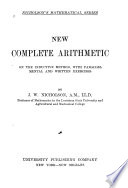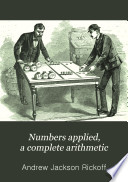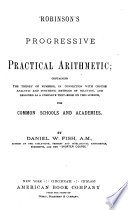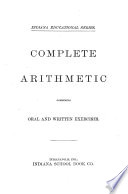 | James William Nicholson - Arithmetic - 1885 - 348 pages
...13 da. from and after Aug. 10, which is Oct. 23. RULE. — Multiply each debt by its term of credit, and divide the sum of the products by the sum of the debts. The quotient will be the average term of credit. This added to the date from which the credits... | |
 | Zalmon Richards - Arithmetic - 1885 - 136 pages
...price and quantity of each simple are given. 1st RULE. — Multiply the number of parts of each simple by its price, and divide the sum of the products by the sum of all the parts. Thus, Bibs, at lOcts., 6lbs. at 12cts., 7lbs. at 14cts., will make 18lbs. at... | |
 | Christian Brothers - Arithmetic - 1888 - 484 pages
...of ^ of 3560 months, which is 4J| months. RULE. — I. Multiply each payment by its term of credit, and divide the sum of the products by the sum of the payments ; the quotient will be the average term of credit. II. Add the average term of credit to the... | |
 | Andrew Jackson Rickoff - Arithmetic - 1886 - 688 pages
...times, by the Method of Products. 339. Rule.— Multiply each item of the debt by ita term of credit, and divide the sum of the products by the sum of the items ; the quotient will be the average term of credit. Note*. — 1. In computing terms of credit,... | |
 | Horatio Nelson Robinson - 1888 - 372 pages
...of 6 months on $30, because 30 x 6 = 180 x 1. RULE. I. Multiply each payment by its term of credit, and divide the sum of the products by the sum of the pay~ vients ; the quotient will be the average term of credit. Average term of credit. Equated time.... | |
 | Warren H. Sadler - 1888 - 426 pages
...should be 5 months after the date of purchase. Rule. — I. Multiply each item by its term of credit, and divide the sum of the products by the sum of the items to find the average term of credit. II. Add the average term of credit to the date of purchase... | |
 | Andrew Jackson Rickoff - 1888 - 464 pages
...times, by the Method of Products. 339.. Rule.— Multiply each item of the debt by its term of credit, And divide the sum of the products by the sum of the items ; the quotient will be the average term of credit. Notes. — 1. In computing terms of credit,... | |
 | Edward Sylvester Ellis - Arithmetic - 1889 - 370 pages
...time, when the terms of credit begin on the same date, — Multiply each debt by its term of credit and divide the sum of the products by the sum of the payments. NOTE. — Whenever cents appear in the debts, they should be rejected if less than 50 and... | |
 | John Homer French - Arithmetic - 1889 - 512 pages
...credit: — PBODUCT METHOD. — Multiply each term of credit by the number expressing the payment, and divide the sum of the products by the sum of the payments. Or, IMTEKEST METHOD. — Find the interest of each debt for its term of credit, and divide... | |
 | Mansfield Merriman - Geodesy - 1903 - 274 pages
...method of computing it is frequently expressed by the rule: Multiply each observation by its weight and divide the sum of the products by the sum of the weights. Prob. 4. Prove the principle (4) directly from the law of probability of error given by (2),... | |
| |